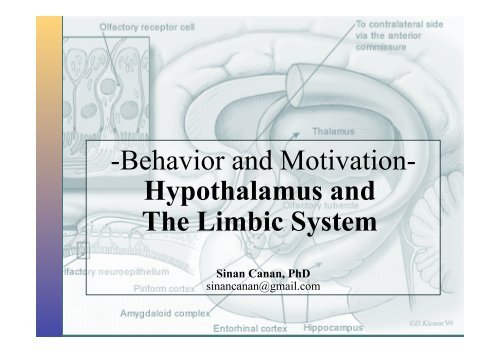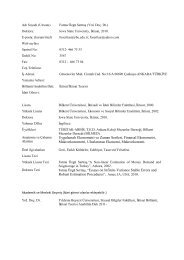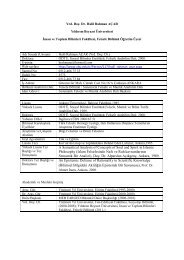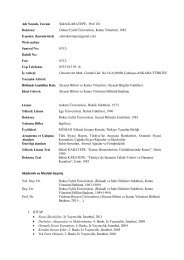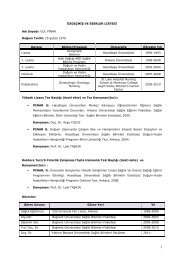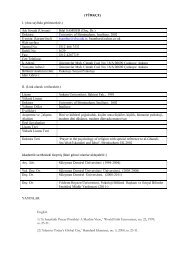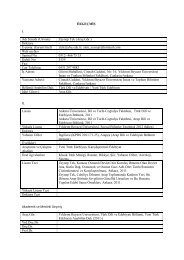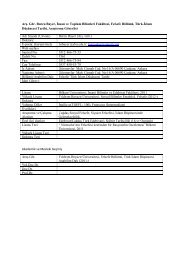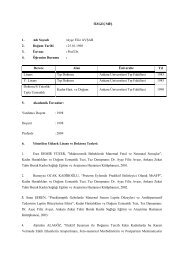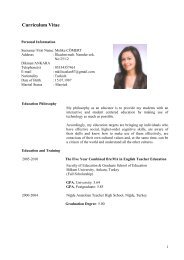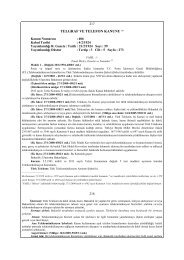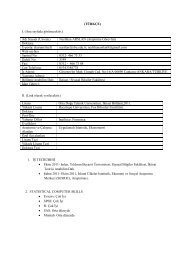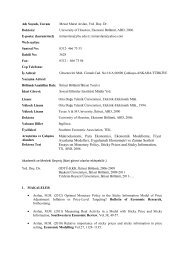Hypothalamus and Limbic System
Hypothalamus and Limbic System
Hypothalamus and Limbic System
You also want an ePaper? Increase the reach of your titles
YUMPU automatically turns print PDFs into web optimized ePapers that Google loves.
-Behavior <strong>and</strong> Motivation-<br />
<strong>Hypothalamus</strong> <strong>and</strong><br />
The <strong>Limbic</strong> <strong>System</strong><br />
Sinan Canan, PhD<br />
sinancanan@gmail.com
<strong>Hypothalamus</strong>
Midbrain (Diencephalon)<br />
• Homeostatic control centers<br />
• Thalamus – “relay station” <strong>and</strong> sensory<br />
integration<br />
• <strong>Hypothalamus</strong><br />
• Hunger/Satiety<br />
• Thirst: Body osmolarity<br />
• “Fight or flight” response<br />
• Rage – fear...<br />
• Control of biological rythms<br />
• Endocrine <strong>and</strong> ANS synchrony
<strong>Hypothalamus</strong><br />
<strong>Hypothalamus</strong><br />
Midbrain<br />
Pons<br />
Hypophysis
Hipotalamus<br />
Blood P; bladder<br />
contraction<br />
Oxytocin, water retention<br />
Hunger<br />
Blood P; mydriasis,<br />
shivering<br />
Neuroendocrine<br />
control<br />
ADH<br />
GIS uyarımı<br />
Satiety,<br />
Neuroendocrine<br />
control<br />
Feeding reflexes
<strong>Hypothalamus</strong><br />
Paraventricular nucleus:<br />
Oxytocin+ADH<br />
Medial preoptic area:<br />
Bladder contraction<br />
Heart rate <br />
Blood pressure#<br />
Supraoptic nucleus:<br />
ADH release<br />
Posterior preoptic <strong>and</strong> anterior<br />
hypothalamus:<br />
Body temperature<br />
Respiration<br />
Sweating
<strong>Hypothalamus</strong><br />
Lateral hypothalamus:<br />
Thirst <strong>and</strong> hunger; Rage!<br />
Arcuate nuclei:<br />
Dopamine, GHRH#<br />
Periventricular area:<br />
Neuroendocrine control<br />
Mamillary body:<br />
Recognition memory, feeding<br />
reflexes<br />
Ventromedial nucleus:<br />
Satiety center, NE control<br />
Perifornical area:<br />
Hunger, Blood pressure , anger
<strong>Hypothalamus</strong><br />
Dorsomedial neucleus:<br />
GIS Stimulation<br />
Posterior hypothalamus:<br />
Blood pressure<br />
Pupil dilatation<br />
Shivering<br />
Suprachiasmatic nucleus:<br />
Biological rhythms<br />
Control of the pineal gl<strong>and</strong>
<strong>Hypothalamus</strong>
<strong>Hypothalamus</strong>
<strong>Hypothalamus</strong>
<strong>Hypothalamus</strong> – Coronal Sections
<strong>Hypothalamus</strong><br />
• Lateral <strong>Hypothalamus</strong> & Medial Forebrain<br />
bundle<br />
• Hunger<br />
• Thirst<br />
• Emotional drive
<strong>Hypothalamus</strong> <strong>and</strong> Behavior<br />
• Lateral <strong>Hypothalamus</strong><br />
• Rage-Euphoria-Fight<br />
• Ventromedial nucleus<br />
• Satiety-calmness<br />
• Periventricular area<br />
• Punishment-fear<br />
• Anterior-posterior hypothalamus<br />
• Sexual instincts
<strong>Hypothalamus</strong> <strong>and</strong> Behavior<br />
• Punishment-Reward <strong>System</strong><br />
• Reward centers<br />
• Lateral hypothalamus<br />
• Ventromedial hypoth.<br />
• Secondary areas:<br />
• Septum<br />
• Amygdala<br />
• Thalamus<br />
• Basal ganglia – basal tegmentum
<strong>Hypothalamus</strong> <strong>and</strong> Behavior<br />
• Punishment-Reward <strong>System</strong><br />
• Punishment centers<br />
• Periventricular area*<br />
• Lateral hypothalamus*<br />
• Suppressing centers:<br />
• VM nucleus<br />
• Hippocampus<br />
• Anterior limbic cortex
<strong>Hypothalamus</strong> <strong>and</strong> Endocrine control
The <strong>Limbic</strong> <strong>System</strong>
The <strong>Limbic</strong> <strong>System</strong><br />
• Limbus: Border, circle<br />
• <strong>Limbic</strong> system<br />
• Cingulate gyrus –<br />
emotions <strong>and</strong><br />
behavior; decision…<br />
• Hippocampus –<br />
learning <strong>and</strong> memory;<br />
navigation<br />
• Amygdala –<br />
emotions <strong>and</strong> emotinal<br />
memory
The <strong>Limbic</strong> <strong>System</strong><br />
• <strong>Limbic</strong> <strong>System</strong><br />
• Cingulate gyrus<br />
• Hippocampus<br />
• Amygdala<br />
• <strong>Hypothalamus</strong><br />
• Mamillary body<br />
• Septum<br />
• Orbitofrontal cortex….
The <strong>Limbic</strong> <strong>System</strong>
The <strong>Limbic</strong> <strong>System</strong>
The <strong>Limbic</strong> <strong>System</strong> - Hippocampus<br />
• Hippocampal formation<br />
• Hippocampus proper<br />
• (Cornu ammonis-CA)<br />
• Gyrus dentatus<br />
• Subiculum<br />
• Enthorhinal cortex<br />
• Fornix
The <strong>Limbic</strong> <strong>System</strong> - Hippocampus<br />
• Hippocampal formation<br />
• Paleocortex<br />
• Laminated structure<br />
• Learning <strong>and</strong> memory<br />
• Short-term memory<br />
• LTP!
The <strong>Limbic</strong> <strong>System</strong> - Hippocampus<br />
CA1<br />
CA2<br />
CA3
<strong>Limbic</strong> <strong>System</strong> – Hippocampus – Papez Circuit
<strong>Limbic</strong> <strong>System</strong> – Hippocampus – Papez Circuit
<strong>Limbic</strong> <strong>System</strong> – Amygdala<br />
Amygdala<br />
Coronal section<br />
Amygdala
<strong>Limbic</strong> <strong>System</strong> – Amygdala – Fear&Phobias
<strong>Limbic</strong> <strong>System</strong> – Amygdala
Feelings <strong>and</strong> motivation<br />
• Cooperative function of:<br />
• <strong>Hypothalamus</strong>, limbic system <strong>and</strong> cortex<br />
• Feelings: Pleasure, sexual arousal, anger <strong>and</strong><br />
fear; limited concious control – hard to block"<br />
• Motivation: driving power;<br />
increases arousal; goal-directed behavioral<br />
coordination
Kluver-Bucy Syndrome<br />
• Extensive damage in<br />
limbic structure<br />
• Feeding disturbances<br />
• Hypersexuality<br />
• Oral focusing<br />
• Loss of fear<br />
• Submission<br />
• Dementia/aphasia/amnesia<br />
• Visual agnosia
Learning <strong>and</strong> memory circuits<br />
Hippocampus<br />
Frontal<br />
cortex<br />
Cortical<br />
regions<br />
Thalamus
That’s all for now...<br />
"If the brain were simple<br />
enough for us to underst<strong>and</strong><br />
it, we would be too simple to<br />
underst<strong>and</strong> it."<br />
Ken Hill<br />
Questions


